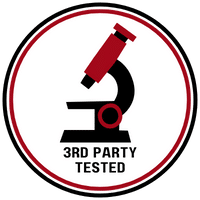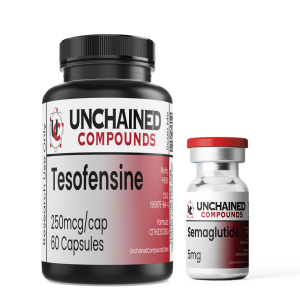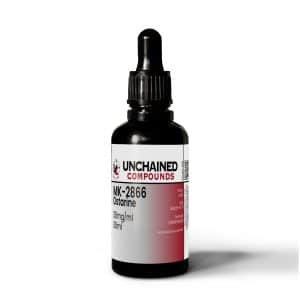Description







CJC-1295 is a synthetic analogue of growth hormone releasing hormone (GHRH) that increases plasma levels of growth hormone and insulin-like growth factor 1 (IGF-1). DAC is an additive moiety that prolongs the plasma half-life of CJC-1295.
Ipamorelin is a synthetic peptide that is composed of five amino acids. It is a GH secretagogue, which means that it stimulates the production of growth hormone. Ipamorelin is also considered to be an agonist, which means that it binds to certain receptors of a cell and provokes a cellular response. The peptide’s operational mechanics enable it to stimulate the production of pituitary gland-based expression of secretions related to growth among animal test subjects. At the same time, the presence of the peptide has been shown to inhibit the production of a secretion known as somatostatin. Additionally, Ipamorelin has been shown to boost the production of IGF-1, or Insulin-like Growth Factor 1. The presence of IGF-1 plays a key role in the overall growth and repair of muscular and skeletal tissue.
Properties
CJC with DAC
- Chemical Formula: C152H252N44O42
- Molecular Mass: 3647.954g/mol
- Synonyms: CJC1295 Without DAC, CJC1295 With DAC, 446262-90-4
- CAS Number: 863288-34-0
- PubChem: 91976842
- Total Amount of the Active Ingredient: 5 mg (1 vial)
- Shelf Life: 36 months
Ipamorelin
- Chemical Formula: C38H49N9O5
- Molecular Mass: 711.868g/mol
- Synonyms: AOD-9604; AOD 9604; AOD9604
- CAS Number: 170851-70-4
- PubChem: 9831659
- Total Amount of the Active Ingredient: 5 mg (1 vial)
- Shelf Life: 36 months
Research Studies
Abstract
Context: Therapeutic use of GHRH to enhance GH secretion is limited by its short duration of action.
Objective: The objective of this study was to examine the pharmacokinetic profile, pharmacodynamic effects, and safety of CJC-1295, a long-acting GHRH analog.
Design: The study design was two randomized, placebo-controlled, double-blind, ascending dose trials with durations of 28 and 49 d.
Setting: The study was performed at two investigational sites.
Participants: Healthy subjects, ages 21–61 yr, were studied.
Interventions: CJC-1295 or placebo was administered sc in one of four ascending single doses in the first study and in two or three weekly or biweekly doses in the second study.
Main Outcome Measures: The main outcome measures were peak concentrations and area under the curve of GH and IGF-I; standard pharmacokinetic parameters were used for CJC-1295.
Results: After a single injection of CJC-1295, there were dose-dependent increases in mean plasma GH concentrations by 2- to 10-fold for 6 d or more and in mean plasma IGF-I concentrations by 1.5- to 3-fold for 9–11 d. The estimated half-life of CJC-1295 was 5.8–8.1 d. After multiple CJC-1295 doses, mean IGF-I levels remained above baseline for up to 28 d. No serious adverse reactions were reported.
Conclusions: Subcutaneous administration of CJC-1295 resulted in sustained, dose-dependent increases in GH and IGF-I levels in healthy adults and was safe and relatively well tolerated, particularly at doses of 30 or 60 μg/kg. There was evidence of a cumulative effect after multiple doses. These data support the potential utility of CJC-1295 as a therapeutic agent.
Abstract
Although the majority of children with isolated growth hormone (GH) deficiency have a good growth response to GH-releasing hormone (GHRH), the use of this therapeutic agent is limited by its very short half-life. Indeed, we have shown that, in mice with GHRH gene ablation (GHRH knockout; GHRHKO), even twice-daily injections of a GHRH analog are unable to normalize growth. CJC-1295 is a synthetic GHRH analog that selectively and covalently binds to endogenous albumin after injection, thereby extending its half-life and duration of action. We report the effects of CJC-1295 administration in GHRHKO animals. Three groups of 1-wk-old GHRHKO mice were treated for 5 wk with 2 μg of CJC-1295 at intervals of 24, 48, and 72 h. Placebo-treated GHRHKO mice and mice heterozygous for the GHRHKO allele served as controls. GHRHKO animals receiving daily doses of CJC-1295 exhibited normal body weight and length. Mice treated every 48 and 72 h reached higher body weight and length than placebo-treated animals, without full growth normalization. Femur and tibia length remained normal in animals treated every 24 and 48 h. Relative lean mass and subcutaneous fat mass were normal in all treated groups. CJC-1295 caused an increase in total pituitary RNA and GH mRNA, suggesting that proliferation of somatotroph cells had occurred, as confirmed by immunohistochemistry images. These findings demonstrate that treatment with once-daily administration of CJC-1295 is able to maintain normal body composition and growth in GHRHKO mice. The same dose is less effective when administered every 48 or 72 h.
Human growth hormone (GH)-releasing hormone (GHRH) is a 44-amino acid peptide that stimulates GH secretion and somatotroph cell proliferation in the pituitary gland through its active 1-29 NH2-terminus peptide (10). Although daily injection of recombinant human GH is presently the only therapeutic option available for patients with GH deficiency (GHD), GHRH may represent a more valid and physiological approach, especially for children with isolated GHD, in whom this condition seems to be related to altered hypothalamic function rather than to impaired GH secretory capacity (16). However, GHRH has limited therapeutical use in children because of its very short half-life (9), requiring multiple daily injections or infusion by a pump. Similarly, we have previously demonstrated that long-term treatment with twice-daily injection of a GHRH superanalog is only partially able to restore somatotroph hypoplasia and growth in the GHRH knockout (GHRHKO) mouse (2).
CJC-1295 is a synthetic human GHRH analog that selectively and covalently binds to endogenous albumin after subcutaneous administration, thereby extending its half-life and duration of action (11, 12). Studies in animals (rats, pigs, and dogs) have shown that several days after a single administration of CJC-1295, serum IGF-I levels are still increased (5). In a recent report, CJC-1295 administered to healthy subjects has been proven to be effective in causing a sustained dose-dependent stimulation of serum GH and IGF-I levels when injected at intervals of 1–2 wk (14).
The primary aim of this study was to determine the minimum frequency of injections that could correct the GHD phenotype in the GH-deficient GHRHKO mice, as measured by improvement of auxological parameters and body composition. Second, we wanted to assess the stimulatory effect of CJC-1295 on somatotroph cell proliferation. We show that once-daily injections of 2 μg of CJC-1295 are able to completely normalize growth. Furthermore, administration of the same dose of CJC-1295 every 48 or 72 h produced intermediate results, indicating an interval-dependent effect.
Abstract
Several peptide drugs are being manufactured illicitly, and in some cases they are being made available to the public before entering or completing clinical trials. At the request of Norwegian police and customs authorities, unknown pharmaceutical preparations suspected to contain peptide drugs are regularly subjected to analysis. In 2009, an unknown pharmaceutical preparation was submitted for analysis by liquid chromatography-high resolution tandem mass spectrometry (LC-HRMS/MS). The preparation was found to contain a 29 amino acid peptide with a C-terminal amide function. Based on the interpretation of mass spectrometric data, an amino acid sequence was proposed. The sequence is consistent with a peptide currently marketed under the name CJC-1295. CJC-1295 is a releasing factor for growth hormone and is therefore considered a Prohibited Substance under Section S2 of the WADA Prohibited List. This substance has potential performance-enhancing effects, it is readily available, and there is reason to believe that it is being used within the bodybuilding community.
Ipamorelin, the first selective growth hormone secretagogue
Abstract
The development and pharmacology of a new potent growth hormone (GH) secretagogue, ipamorelin, is described. Ipamorelin is a pentapeptide (Aib-His-D-2-Nal-D-Phe-Lys-NH2), which displays high GH releasing potency and efficacy in vitro and in vivo. As an outcome of a major chemistry programme, ipamorelin was identified within a series of compounds lacking the central dipeptide Ala-Trp of growth hormone-releasing peptide (GHRP)-1. In vitro, ipamorelin released GH from primary rat pituitary cells with a potency and efficacy similar to GHRP-6 (ECs) = 1.3+/-0.4nmol/l and Emax = 85+/-5% vs 2.2+/-0.3nmol/l and 100%). A pharmacological profiling using GHRP and growth hormone-releasing hormone (GHRH) antagonists clearly demonstrated that ipamorelin, like GHRP-6, stimulates GH release via a GHRP-like receptor. In pentobarbital anaesthetised rats, ipamorelin released GH with a potency and efficacy comparable to GHRP-6 (ED50 = 80+/-42nmol/kg and Emax = 1545+/-250ng GH/ml vs 115+/-36nmol/kg and 1167+/-120ng GH/ml). In conscious swine, ipamorelin released GH with an ED50 = 2.3+/-0.03 nmol/kg and an Emax = 65+/-0.2 ng GH/ml plasma. Again, this was very similar to GHRP-6 (ED50 = 3.9+/-1.4 nmol/kg and Emax = 74+/-7ng GH/ml plasma). GHRP-2 displayed higher potency but lower efficacy (ED50 = 0.6 nmol/kg and Emax = 56+/-6 ng GH/ml plasma). The specificity for GH release was studied in swine. None of the GH secretagogues tested affected FSH, LH, PRL or TSH plasma levels. Administration of both GHRP-6 and GHRP-2 resulted in increased plasma levels of ACTH and cortisol. Very surprisingly, ipamorelin did not release ACTH or cortisol in levels significantly different from those observed following GHRH stimulation. This lack of effect on ACTH and cortisol plasma levels was evident even at doses more than 200-fold higher than the ED50 for GH release. In conclusion, ipamorelin is the first GHRP-receptor agonist with a selectivity for GH release similar to that displayed by GHRH. The specificity of ipamorelin makes this compound a very interesting candidate for future clinical development.
Abstract
Background
Delayed gastric emptying is a common disorder with few effective therapeutic options. The goal of this study was to investigate whether ipamorelin, a synthetic peptidomimetic that acts on the ghrelin receptor, accelerates gastric emptying in a rodent model of gastroparesis induced by abdominal surgery and intestinal manipulation.
Methods
Fasted adult male rats were subjected to laparotomy and intestinal manipulation. Following the surgery rats received ipamorelin (0.014–0.14 µmol/kg) or vehicle control via intravenous administration. Gastric emptying was measured by the percent of total recovered radioactivity remaining in the stomach 15 minutes after intragastric gavage of 1.5 mL of 99mTc (technicium-99m) sulfur colloid in 0.5% methylcellulose. In a separate group of rats subjected to laparotomy and intestinal manipulation, the gastric fundus was isolated and tissue segments were suspended in an organ bath to assess the effect of ipamorelin (1 µM) on gastric smooth muscle contractility induced by acetylcholine and electrical field stimulation.
Results
Abdominal surgery caused a delay in gastric emptying with 78% ± 5% of the meal remaining in the stomach in vehicle controls. Ipamorelin (0.014 µmol/kg intravenous) resulted in a significant acceleration (P < 0.05 vs vehicle-treated rat) of gastric emptying with 52% ± 11% of the meal remaining in the stomach compared to nonsurgical control animals with 44% ± 6%. Following abdominal surgery and intestinal manipulation, isolated preparations of gastric smooth muscle exhibited a marked inhibition of acetylcholine and electrical field stimulation-induced contractile responses, which were reversed by ipamorelin and ghrelin.
Conclusion
These results suggest that ipamorelin accelerates gastric emptying in a rodent model of postoperative ileus through the stimulation of gastric contractility by activating a ghrelin receptor-mediated mechanism involving cholinergic excitatory neurons.
Do growth hormone-releasing peptides act as ghrelin secretagogues?
Abstract
NN703 is an orally active and selective growth hormone secretagogue (GHS) that was derived from growth hormone-releasing peptide-1 (GHRP-1) via ipamorelin by a peptidomimetic approach and has now entered into phase II clinical trials. When the disposition in rats of NN703 and GHRP-6 was studied using whole-body autoradiography following administration of an iv dose of radiolabeled material, we found that a substantial amount of these secretagogues accumulate in the glandular part of the stomach. Because this is the site of synthesis and secretion of ghrelin, the endogenous GHS, we investigated the effect of resection of the gastrointestinal (GI) tract on growth hormone (GH) release induced by GHRP-6. This procedure significantly attenuated the GH secretion response by 60–70%. By contrast, the effect of GH-releasing hormone on GH release was not inhibited. The binding of GHRPs to the glandular part of the stomach and the blunted GH response to GHRP-6 following resection of the GI tract suggest a role for ghrelin as a mediator of part of the GH-releasing effect of GHRPs.
Disclaimer
The information provided above is not intended to substitute medical advice, diagnosis, or treatment. Should you have any questions regarding a medical condition, seek the advice of your physician or a qualified healthcare provider. In no case should medical advice be disregarded or delayed because of what you have read or seen. We bear no responsibility or liability for your use of any of our research compounds and products. Please note that they are being sold for research purposes ONLY. We do NOT condone any personal use.
NOTE: In some cases wherein the assigned top colors are out of stock, a different top color will be used to ensure that your order will not be delayed. Should you need assistance identifying the peptide vial that you received, please send us an email at support@unchainedcompounds.store.
ALL ARTICLES AND PRODUCT INFORMATION PROVIDED ON THIS WEBSITE ARE FOR INFORMATIONAL AND EDUCATIONAL PURPOSES ONLY.
The products offered on this website are intended for in-vitro studies only. In-vitro studies (Latin: “in glass”) are performed outside the body. These products are not medicines or drugs and have not been approved by the FDA to prevent, treat, or cure any medical condition, ailment, or disease. Bodily introduction of any kind into humans or animals is strictly forbidden by law.








